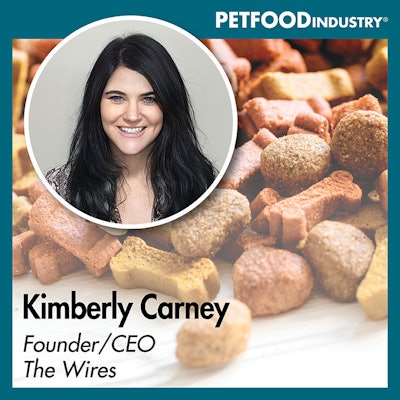
In this episode of Trending: Pet Food, Host Lindsay Beaton speaks with Kimberly Carney, CEO and founder of PawWire, about the evolution and challenges of digital business strategies in the pet industry. The conversation explores key challenges facing pet brands, including market saturation, influencer overload, and the constant pressure to create engaging content while maintaining customer loyalty. Carney highlights successful examples while offering practical advice for businesses looking to build genuine, ongoing relationships with their customers rather than focusing solely on one-time transactions.
In this episode of Trending: Pet Food, Lindsay Beaton speaks with Kimberly Carney, CEO and founder of PawWire, about the evolution and challenges of digital business strategies in the pet industry. Carney traces the rapid transformation from basic e-commerce in 2015 to today's AI-integrated omnichannel experiences, exploring key challenges like market saturation and the constant pressure to create engaging content. The episode originally aired on August 20, 2025.
We want to thank AFB International for sponsoring this podcast. AFB is the premier supplier of palatants to pet food companies worldwide, offering off-the-shelf and custom solutions and services that make pet food treats and supplements taste great.
Lindsay Beaton, editor, Petfood Industry magazine and host, Trending: Pet Food podcast: Hello, and welcome to Trending: Pet Food, the industry podcast where we cover all the latest hot topics and trends in pet food. I'm your host and editor of Petfood Industry magazine Lindsay Beaton, and I'm here today with Kimberly Carney, CEO and founder of PawWire. Hi Kimberly, and welcome!
Kimberly Carney, CEO and founder of PawWire: Hi! Thank you so much for having me.
Beaton: In case you're unfamiliar with Kimberly or PawWire, here's what you need to know.
Kimberly Carney is the CEO and founder of The Wires, the parent company to three cutting-edge, data-driven retail-tech companies: GlossWire, FashWire and PawWire. Each of these innovative B2B2C marketplace platforms is designed to help brands drive growth and innovation across various industries, from beauty and fashion to the pet sector. With extensive experience as an executive in both tech and retail, as well as a seasoned strategist, thought leader, and retail store owner, Kimberly leverages her expertise in retail, technology, AI and data monetization to provide actionable insights and customized solutions that accelerate brand success.
The Wires three B2B2C platforms aim to transform the way fashion, beauty, and pet brands engage with consumers by offering a seamless interactive experience through real-time digital engagement.
Kimberly's depth of digital business knowledge across multiple industries is why I've brought her on today to answer this question: What does a successful digital business strategy look like in the pet industry?
Kimberly, a lot of times when we're about to have these types of conversations, I like to talk about the history and evolution of technology and the digital space. How have digital strategies evolved over the last several years when it comes to various businesses?
Carney: I think in the pet industry, they've undergone significant evolution over the past several years. The shifts reflect broader changes in consumer behavior with advances in technology and the growing importance of e-commerce and online engagement.
If we go back to 2015, there was early digital adoption with website presence and e-commerce beginnings. Pet brands began establishing websites, many of which functioned primarily as informational resources. Email marketing was also significant during this period.
From 2015 to 2017, we saw the rise of social media with increased social media engagement. User-generated content started coming into play, along with influencer marketing.
From 2017 to 2019, content marketing and personalization became key. Websites with rich blogs gained traction with their users, coupled with personalized shopping experiences. Video and interactive content and mobile optimization became important.
Since right before the pandemic up to about 2020, e-commerce really dominated because of the pandemic. Subscription models and automatic ship models started coming into play. Live streaming and virtual events became popular among social media platforms, along with the introduction of AI and chatbots.
Now everything is focused on that omnichannel experience with AI integration. That's really been the focus for pet brands — creating the seamless shopping experience where customers can interact with the brand across multiple touchpoints: websites, mobile apps, physical stores and social media without any disruption. For example, a customer might interact with a brand via Instagram, then purchase a product via the website, but then pick it up at the local store. AR (augmented reality) is still fine-tuning itself in other verticals, but omnichannel strategies are what's super relevant right now.
Beaton: That's a lot of evolution in a fairly short amount of time. It can be difficult to determine who is driving all of this. Do you feel it's been more consumer-driven, with consumers wanting more of a relationship with the brands they interact with, and then reactionary on the industry's part? Or do you think there are leaders in the industry who are promoting these technologies and allowing consumers to discover these types of digital technologies?
Carney: I think the consumer is driving the path forward, because consumers are particular about what they'll buy. They really want brand authenticity, but they also want that seamless experience.
The evolution has gone quickly from basic e-commerce and early-stage social media to the data-driven omnichannel approaches we see now. The rise of personalization, AI and immersive technologies have all been consumer-driven, because for brands to sell their products, they need to make products the consumer wants to buy. The best way to do that is to get the feedback and interest from consumers — what they're saying and what they want — and really go to platforms such as PawWire, where they can get that seamless experience. We're able to give that feedback to the brands.
Beaton: There's a lot of conversation in the pet space about how to communicate with not just consumers in general, but the consumers that a particular brand wants to target. What do you think are some of the top challenges right now in creating an effective digital strategy that will reach consumers in the ways that you want it to reach?
Carney: We're in a highly competitive market. It's an overcrowded digital space. With the pet industry growing rapidly, there's saturation of brands competing for consumer attention — from large companies like Petco and Chewy to niche startups offering specialized pet products. Standing out in a crowded market is a significant challenge. Pet brands need to consistently differentiate themselves with unique value propositions, engaging content and personalized experiences.
The other side of this highly competitive market is influencer overload. The rise of pet influencers — while it's a great strategy — can also be overwhelming for brands. With so many influencers seeking attention, it can be difficult to find the right ones who genuinely align with the brand and provide meaningful results. There's also the risk of influencer fatigue, where audiences start tuning out overly branded content.
Another big challenge is maintaining customer loyalty and engagement. Customer retention versus acquisition — while attracting new customers through digital channels is important, retaining them is extremely important. The pet industry has high churn rates, especially with products like food and toys that can be easily replaced. Keeping customers engaged through email marketing, loyalty programs and personalization is key, but it's challenging to constantly meet expectations and avoid getting lost in the noise of promotions.
There's also constant content demand. Content creation is vital for brands to keep consumers engaged, whether it's blog posts, social media, videos or user-generated content. However, the pressure to consistently create content is difficult and challenging for many brands, especially small- to mid-sized businesses.
Data privacy and collection concerns also impact consumers and their spending habits. Personalization is one of the most powerful tools available to pet brands today. However, how you collect consumer data for personalized experiences can run into legal and ethical issues, especially with stricter regulations around data privacy — balancing personalization with consumer expectations.
Finally, keeping up with technology as well as supply chain and fulfillment issues are the biggest challenges I think pet brands are facing.
Beaton: All that sounds like a recipe for burnout. There are a lot of businesses — most businesses in the pet industry — that are small- to mid-sized, and they have the marketing teams to match. In a lot of companies, there are a few people doing a lot of work, and nobody can be on every channel effectively. You can surely get the handles and get your stuff out there, but in terms of truly being able to engage, it must be impossible to effectively engage on every single channel.
How does a company sit down with their digital business plan and decide -- these are the channels we have the energy to focus on, and these are the channels that we should be focusing on? Are there any kind of checklists or mental frameworks that a business should go through to see where they should really be focusing their marketing efforts?
Carney: For brands to stand out, part of their sales and marketing plan is that they have to adapt to rapidly changing technology. They must be agile and strategic in navigating all the different channels and determining which ones are a priority for them. I think every brand is different. The brands that will succeed will be those that find innovative ways to engage their audience, build trust and stay ahead of digital trends while ensuring a seamless, focused, and consumer-focused experience. That's how they narrow down what their offering is.
I think it's super important, especially for consumers now who want authenticity and personalization and seamless experience — brands must be agile. They must adapt to technology. That's where brands should start: the technology experience on their commerce sites.
Beaton: Where have you seen companies fail when they're coming up with a digital brand experience or an overall digital business strategy?
Carney: I think failure to differentiate in a crowded market is key. It's a struggle with the pet industry because the pet industry has seen explosive growth, and as a result, there's an overwhelming number of players, big and small, competing for the same consumer attention. From established brands like Petco and PetSmart to a growing number of boutique e-commerce stores and niche products, standing out becomes incredibly difficult. Companies often rely too much on price, and the challenge becomes finding that unique selling proposition that resonates with pet owners.
Where they fail is they fail to understand or tap into what makes their brand unique, or they overestimate how much consumers are willing to pay for convenience or broad product selection. A lack of authentic storytelling, an unrefined brand voice, and generic messaging all contribute to falling flat in this mass of similar offerings.
Take Petco, for example. It has a huge footprint in the physical retail space, and it often struggled to differentiate itself from its competitors. In contrast, newer brands like Chewy have excelled in offering superior customer service, easy returns, and an e-commerce-first strategy. Petco failing to create a compelling digital-first experience made it more challenging to engage younger, more digital-savvy consumers.
Another area where I've seen brands fail is keeping up with technology changes. The digital world is evolving quickly, and there's so much at our fingertips now with AI, AR and machine learning that really does enhance customer experiences. But that requires heavy investment in resources, time and talent, and smaller brands really have a tough time thriving in that advanced technology environment while trying to keep up. The key is not to be too slow to adopt or make sure you're implementing what you need to well.
Beaton: Does that mean that a digital business strategy is essentially an ever-evolving document? Can a company come up with a strategy and be good for the next two years, or is it something that they need to be constantly reevaluating, given how quickly everything is changing in the digital space?
Carney: With consumer demand, I think they constantly have to be looking at their data, looking at their customer journey, and figuring out where people drop off, where they go away, when they're purchasing. I think they consistently must stay ahead of technology to really advance forward in such a digital time.
Beaton: We're obviously talking about a complex prospect, something that requires a lot of time and effort and constant vigilance. You've worked in multiple industries, not just the pet space. What companies have you seen do this incredibly well? Doesn't have to be a pet company, just somebody that you think is a prime example of really nailing the digital business strategy and being able to reach their consumers.
Carney: I think BarkBox, staying with the pet industry, is a great example of a brand that successfully turned customer acquisition into retention through a well-designed subscription model. On the other hand, Petco's retail-heavy strategy limits the ability to create a strong digital loyalty loop, making it harder for brands to have long-term relationships. But BarkBox's subscription model really helped, and that's another form of digital that helps keep consumers engaged as well.
I also think brands that fully integrate their digital and physical experience, like Chewy has done, have managed to create a more consistent and seamless experience, which keeps customers returning, which is why Chewy is so popular.
Beaton: We've talked about challenges, and we've talked about what companies are doing and where they might go wrong and where they might go right. Are there any opportunities that you see right now that companies are not taking enough advantage of?
Carney: There are so many opportunities right now for digital success, especially as consumer behavior continues to evolve and technology advances. Personalization at scale — there's such a huge opportunity there, because consumers want products tailored to their specific needs, whether it's pet food that's customized for breed, size, health conditions or personalized recommendations for pet accessories. The key opportunity here lies in utilizing customer data responsibly to offer highly personalized experiences across digital channels. Chewy has perfected the art of personalization through its auto-ship feature and personalized product recommendations. It's super helpful when brands can adopt those strategies.
It doesn't always mean putting a whole bunch of money into it, because there are so many free tools out there with AI and digital experience that brands could be using, or they could focus on partnerships with different technology companies that could really help.
The other thing is subscription-based models. BarkBox did a great job with that, and we've seen a boom with subscription models. As customers enjoy the convenience and cost savings associated with deliveries of pet products — food, toys, grooming supplies — the opportunity lies in offering owners tailored subscription models that ensure they never run out of essential pet care items.
Beaton: Is there anything that you think is going to be particularly interesting about digital business strategy coming up in the next couple of years? What are you watching most closely?
Carney: I'm still watching e-commerce and direct-to-consumer sales. I think there's still such a big opportunity with that through digital because the shift towards e-commerce continuously grows. Pet owners are turning to online shopping for many things, especially pet food to accessories. The rise of these D-to-C channels where pet brands can sell directly to consumers and control the experience really provides a unique opportunity for brands to create a closer connection with their customers while avoiding the high cost of traditional retail. Online sales really continue to be where the opportunity is.
Beaton: We've covered a lot of ground. As we wrap up our conversation, I want to talk advice. If there were one or two pieces of advice you could give to a business listening right now about their digital strategy, what would it be?
I want to do it two-pronged. One, somebody who has not looked at their digital strategy for a while and actively wants to improve or create one. And then, for somebody who has an established business strategy, what would your advice for them be? Two different groups of people.
Carney: That would be the same: focus on building a genuine, ongoing relationship with your customers, not just a one-time transaction. Building the relationship with your customers is the key to success.
Beaton: Thanks for coming on today, Kimberly. As the digital space and its opportunities — and challenges — continue to grow, helping businesses navigate their options is going to be more important than ever. Before we go, let's do a little plug: Where can people find more information about you and PawWire?
Carney: You can go to pawwire.com. You can find us on Instagram @PawWire, P-A-W-W-I-R-E. We are on the app store as well for PawWire, and you can download the app and discover brands from all over the world.
Beaton: Perfect. That's it for this episode of Trending: Pet Food. You can find us on petfoodindustry.com, SoundCloud or your favorite podcast platform. You can also follow us on Instagram @trendingpetfoodpodcast. If you want to chat or have any feedback I'd love to hear from you, feel free to drop me an email [email protected].
Of course, thanks again to our sponsor, AFB International, the premier supplier of palatants to pet food companies worldwide, offering off-the-shelf and custom solutions and services that make pet food, treats and supplements taste great.
Once again, I'm Lindsay Beaton, your host and editor of Petfood Industry magazine, and we'll talk to you next time. Thanks for tuning in!

















